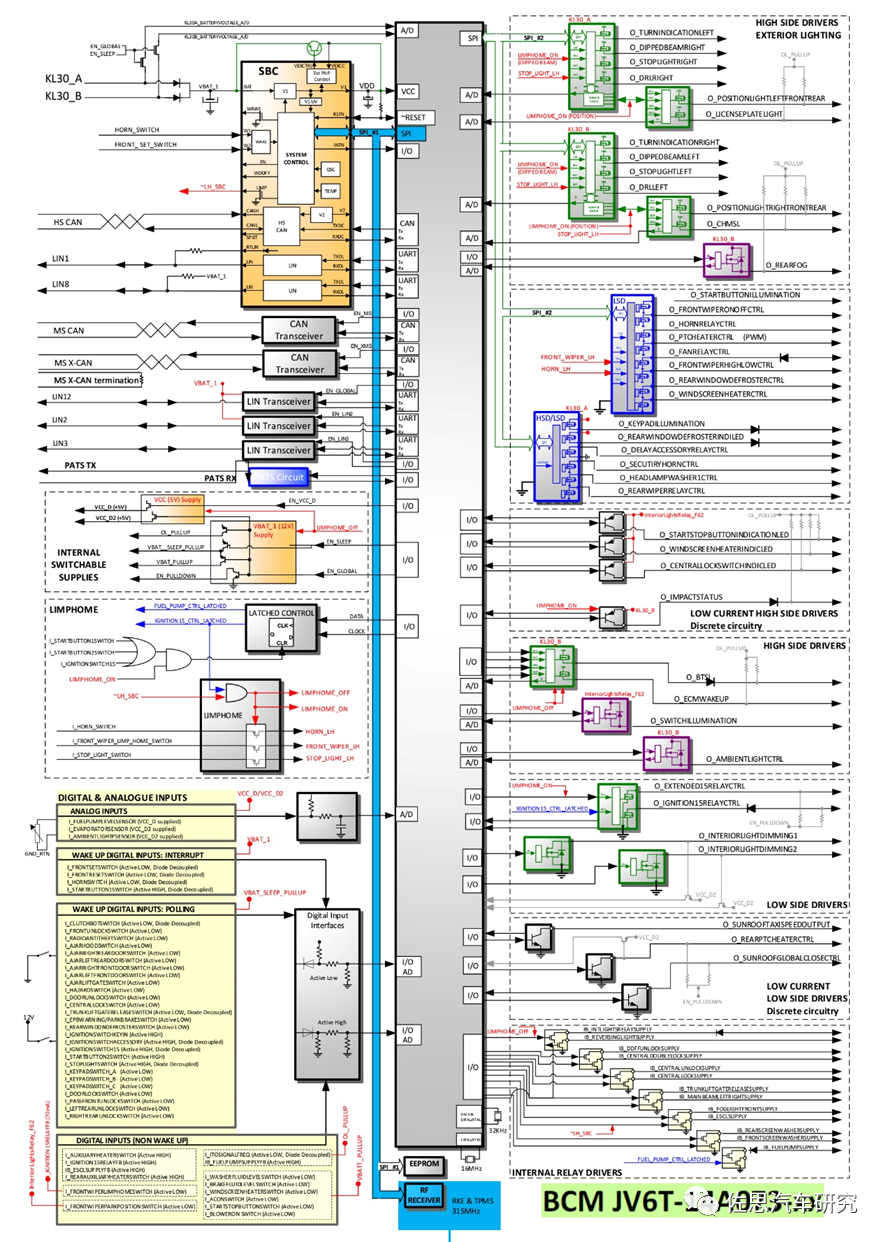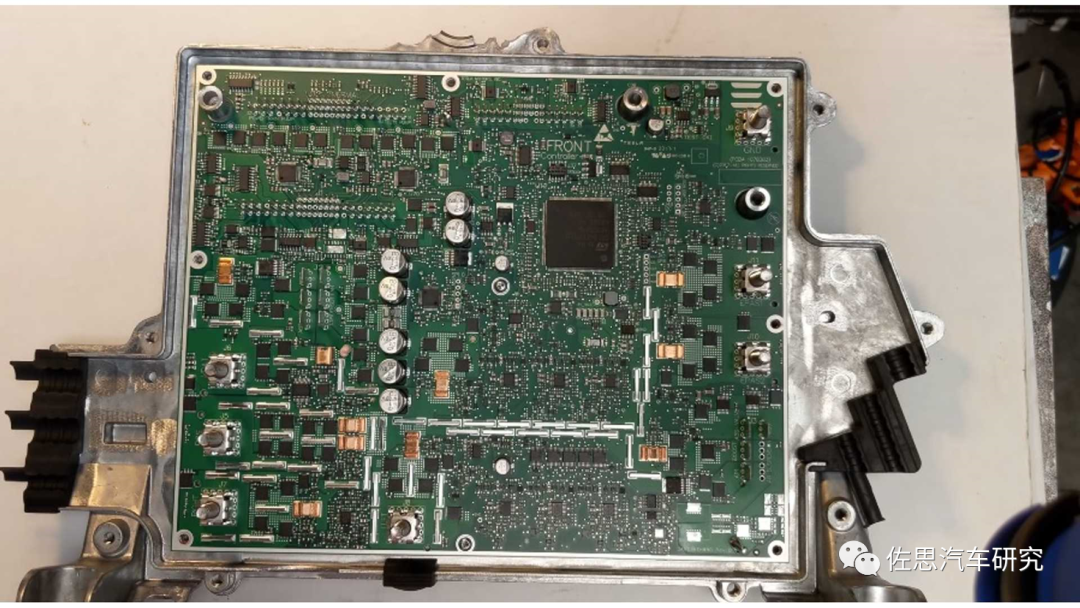The body controller usually controls functions such as doors, lights, car keys, diagnostics, wipers and steering wheel heating, and is usually relatively simple. However, car keys are becoming more and more complex, with the addition of Bluetooth and UWB. Usually, the body controller does not add these complex RF wireless parts, only the most basic car key part is added, and UWB and LIN are connected to the body controller through a gateway. The latest body controller adds a SoC with a slightly larger computing load and an Ethernet channel, mainly to deal with OTA. Another example is Tesla, which increases integration by region, and also adds body controllers for the roof, HVAC and seats. Traditional car manufacturers have dispersed these.

Image credit: Ford
The picture above is the latest body controller circuit diagram of a US car manufacturer. Most body controller circuit diagrams are similar, with the core MCU in the middle. The most common ones are STMicroelectronics' SPC56 and SPC58 series.

Volkswagen MQB37W series body controller framework. Image source: Volkswagen
Continental and Bosch both supply body controllers to Volkswagen.

The wiring slot on the surface of the Volkswagen MQB37W body controller. Image source: Volkswagen

Volkswagen MQB37W traditional car key corresponding circuit framework. Image source: Volkswagen

Image source: Volkswagen
The front of the Volkswagen MQB37W series body controller circuit board, the main MCU is STMicroelectronics' SPC58.

The back of the Volkswagen MQB37W series body controller circuit board. Image source: Volkswagen

Tesla body controller framework diagram. Image source: Tesla
Tesla has three body controllers, with the main controller located on the right.

The front of Tesla's front main body controller. Image source: Tesla

The back of Tesla's front body controller. Image credit: Tesla

Image source: Tesla
Tesla has three body controllers. The disassembled circuit boards are shown in the figure above. The most well-known one is the body controller on the far right, which Tesla calls VCFRONT (Front Body Controller). Tesla divides the body controllers by region, while traditional car manufacturers divide them by function. The advantage of Tesla's approach is that the wiring harness is shorter and simpler, the wiring harness cost is greatly reduced, and the assembly speed of the whole vehicle is greatly increased. The disadvantage is that several controllers are required. Another feature of Tesla is that it does not use fuses. Tesla's regional body controller is not advanced, and is not much different from the body controllers of traditional car manufacturers, but the integration is slightly higher. All core chips are STMicroelectronics' SPC56 series MCUs, which are slightly lower than Volkswagen's SPC58 series.

Image source: Tesla
On the front of the body controller, key chips include STMicroelectronics' SPC56EC74L8, a 32-bit MCU, e200z4d core 32-bit Power architecture, 200 MIPs at 120 MHz, 3 MByte on-chip Flash with ECC, 256 KByte on-chip SRAM with ECC, 6 CAN interfaces, 10 LIN interfaces, and 8 DSPI. Tesla uses an old product, while Volkswagen uses a new product, the SPC58, which has passed ASIL-B certification and has a more advanced core, the e200z420n3, with higher computing power, an operating frequency of 180MHz, and up to 4224KB on-chip flash memory. It also supports more interfaces, including 18 LIN, 8 CAN (including CAN-FD), and dual-channel FlexRay. LV8907, ON Semiconductor's brushless motor controller, is used to control the air conditioner fan motor. It has three ON Semiconductor 20A Schottky diodes, model MBR2045EMFS, ON Semiconductor's MOSFET, model NVMFS5C426N, domestic Nexperia's PMEG045V050EPD double-sided switch, Infineon's BTS5020-2EKA single-sided switch, Infineon's BTS5008-1EKB and NXP's PA9539RPW (2), low power I/O port.

Image source: Tesla
From the appearance of BMW body controller BDC03, it is easy to see that it is supplied by Visteon. The previous generation body controller was supplied by Lear's EEDS department.

Image source: BMW
The picture above shows the front of the circuit board after BDC03 is disassembled. The largest chip is the Renesas MCU, and the power chip of the MCU is on the right. The chip in the middle seems to be an Ethernet switch, which should be a chip customized by Broadcom. The chip on the lower right may be a physical layer chip. Compared with Tesla Model 3, BMW's body controller is also much more advanced, and BMW's diagnosis and OTA should be more powerful.
Previous article:Jargon in the autonomous driving circle: Common point cloud registration methods and future development directions
Next article:NXP Automotive CAN Network
- Huawei's Strategic Department Director Gai Gang: The cumulative installed base of open source Euler operating system exceeds 10 million sets
- Analysis of the application of several common contact parts in high-voltage connectors of new energy vehicles
- Wiring harness durability test and contact voltage drop test method
- Sn-doped CuO nanostructure-based ethanol gas sensor for real-time drunk driving detection in vehicles
- Design considerations for automotive battery wiring harness
- Do you know all the various motors commonly used in automotive electronics?
- What are the functions of the Internet of Vehicles? What are the uses and benefits of the Internet of Vehicles?
- Power Inverter - A critical safety system for electric vehicles
- Analysis of the information security mechanism of AUTOSAR, the automotive embedded software framework
 Professor at Beihang University, dedicated to promoting microcontrollers and embedded systems for over 20 years.
Professor at Beihang University, dedicated to promoting microcontrollers and embedded systems for over 20 years.
- Innolux's intelligent steer-by-wire solution makes cars smarter and safer
- 8051 MCU - Parity Check
- How to efficiently balance the sensitivity of tactile sensing interfaces
- What should I do if the servo motor shakes? What causes the servo motor to shake quickly?
- 【Brushless Motor】Analysis of three-phase BLDC motor and sharing of two popular development boards
- Midea Industrial Technology's subsidiaries Clou Electronics and Hekang New Energy jointly appeared at the Munich Battery Energy Storage Exhibition and Solar Energy Exhibition
- Guoxin Sichen | Application of ferroelectric memory PB85RS2MC in power battery management, with a capacity of 2M
- Analysis of common faults of frequency converter
- In a head-on competition with Qualcomm, what kind of cockpit products has Intel come up with?
- Dalian Rongke's all-vanadium liquid flow battery energy storage equipment industrialization project has entered the sprint stage before production
- Allegro MicroSystems Introduces Advanced Magnetic and Inductive Position Sensing Solutions at Electronica 2024
- Car key in the left hand, liveness detection radar in the right hand, UWB is imperative for cars!
- After a decade of rapid development, domestic CIS has entered the market
- Aegis Dagger Battery + Thor EM-i Super Hybrid, Geely New Energy has thrown out two "king bombs"
- A brief discussion on functional safety - fault, error, and failure
- In the smart car 2.0 cycle, these core industry chains are facing major opportunities!
- The United States and Japan are developing new batteries. CATL faces challenges? How should China's new energy battery industry respond?
- Murata launches high-precision 6-axis inertial sensor for automobiles
- Ford patents pre-charge alarm to help save costs and respond to emergencies
- New real-time microcontroller system from Texas Instruments enables smarter processing in automotive and industrial applications
- EEWORLD University ---- Practical Guide to Motor Application Development - Based on STM32
- [XMC4800 Relax EtherCAT Kit Review] + Getting started with DAVE, quickly build your own webserver
- Banknote number recognition system based on ARM.pdf
- My knowledge of computers
- [Sipeed LicheeRV 86 Panel Review] 7-Waft Graphical Interface Development Test (Part 2)
- Wifi controlled LED screen
- IIoT opens up more possibilities beyond the factory floor
- Recommended one: [Lingsheng] MCU code automatic generator (automatic programming tool)
- Learning 3D visualization scene hierarchy from scratch (1)
- What are the differences and connections between compilers and integrated development environments?

 Automotive Electrical and Electronics (Fifth Edition, James D. Halderman)
Automotive Electrical and Electronics (Fifth Edition, James D. Halderman)
















 京公网安备 11010802033920号
京公网安备 11010802033920号